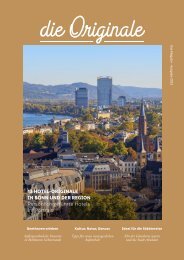LUXAIR_LUXiClub_So12 ls
p o
p
o
Create successful ePaper yourself
Turn your PDF publications into a flip-book with our unique Google optimized e-Paper software.
Number 43, Fall 2002
cartographic perspectives 17
1. Birney did not include etymological notes with “Mappemounde.”
Unless otherwise noted, medieval English translations and etymologies
derive from Jember 1974, Borden 1982, and the second edition of
the Oxford English Dictionary (OED 1989); Latin phrases, from Lewis
and Short [1879] 1975, and Niermeyer and van de Kieft 1976. (Note
that the Old French word for “great whale” spawned the medieval
English Cethegrande.)
2. Regarding these revisions, the following do not affect the poem’s
meaning: the replacement of “NO” by “No” (line 1) or of “the dear
face-charm” by “the brave picture-faces” (line 8); the fact that “in”
ends line 9 instead of beginning line 10. More significant are two
changes discussed below: Birney’s replacement of “that” by “which”
(line 3) and his typographic alterations. The typography Birney
adopted in Selected Poems 1940-1966 and later collections remains
controversial (Birney 1966, ix; Nesbitt 1974, 10, 142-43, 153-54, 159-
60, 212-13).
3. The French word mappemonde derives from the medieval Latin mappa
mundi. The forms mappemond and mappemonde also appear in Middle
English (OED 1989). For French spellings prior to 1500, see Tobler
and Lommatzsch 1963, 5:1102-1103, s.v. mapemonde (with alternatives
mappamonde and mappemonde) as well as “mapemont” (with
mapemund). Birney helped his Canadian readers translate his title
“Mappemounde” by reminding them of their high-school French
(Birney 1972, 84).
4. The quote comes from an edition familiar to Birney: Skeat [1894-
1900] 1926-54, 1:389. Skeat, who first published the poem and gave it
a title, notes that the late fifteenth-century manuscript containing the
untitled poem actually uses the spelling mapamonde. The current edition
spells the word mapamounde (Benson 1987, 649). Chaucer’s contemporary,
John Gower, also uses the word in his Confessio Amantis:
“And sette proprely the bounde/ Aftre the forme of Mappemounde”
(3.102: OED 1989).
5. At the time when Birney was composing “Mappemounde,” the
great compendium of medieval maps was Miller (6 vols., 1895-98).
Also important were works by A.E. Nordenskiöld (1890s), Charles
Raymond Beazley, especially The Dawn of Modern Geography (3 vols.,
1897-1906), J.K. Wright, and Richard Uhden (1930s); see Woodward
1987, 513-558, for fuller bibliography.
6. Harvey suggests that the Psalter Map was drawn in London (1996,
29). According to Delano-Smith and Kain (1999, 38), “about two
dozen English mappaemundi are known (excluding 19 copies of the
Higden map) of which fewer than half are extant.” (The Higden map
illustrated the Polychronicon of Ranulf Higden, a fourteenth-century
monk from Chester; see Harvey 1997, 35.)
7. The manuscript in which the Anglo-Saxon map appears features a
zonal map as well (McGurk 1983, 65-66); both seem to have been
drawn by the same person to suit the manuscript’s “overall plan”
(Edson 1997, 3, and 77-78, 95, 106-107). Delano-Smith and Kain
suggest that the “apparent dearth [of English mappaemundi] from
the seventh to the twelfth centuries may be due to rarity or to loss”
(1999, 8).
8. The Albi mappamundi of the eighth century and the Ashburnham
Beatus map of the tenth have rectangular frames (McGurk 1983, 79
and 85; Woodward 1987, 348, fig.18.56; Williams 1998, 3:27-28). On
the shapes of mappaemundi and their symbolism, see Woodward
1987, 318 n.149.
NOTES















